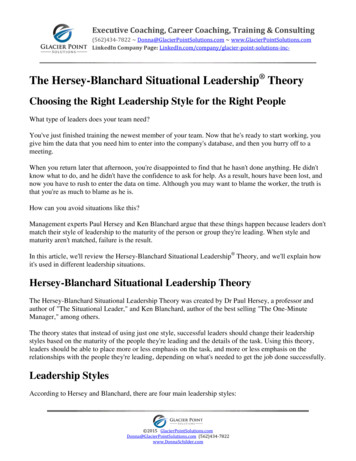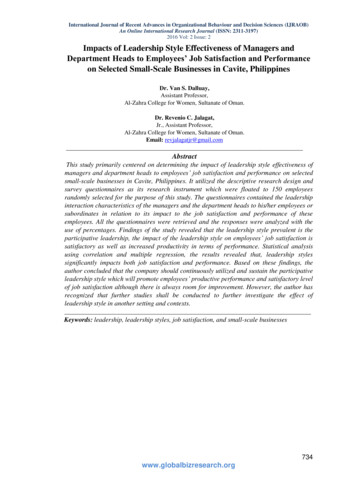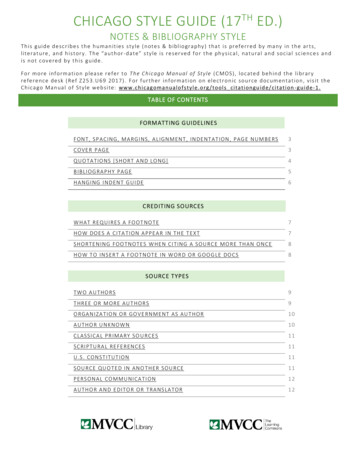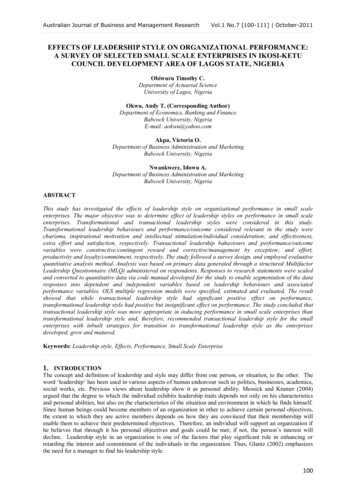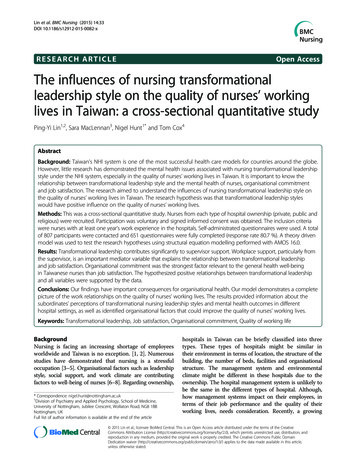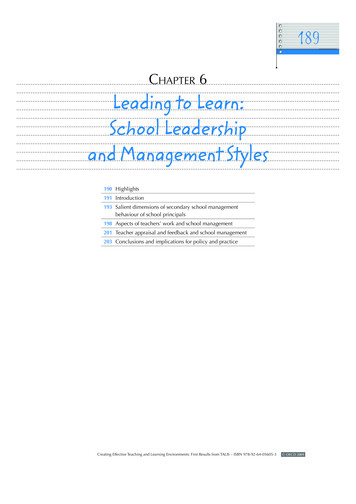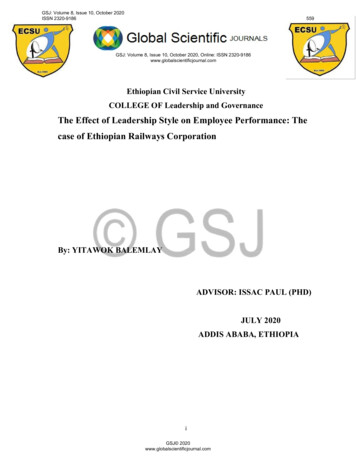
Transcription
GSJ: Volume 8, Issue 10, October 2020ISSN 2320-9186559GSJ: Volume 8, Issue 10, October 2020, Online: ISSN 2320-9186www.globalscientificjournal.comEthiopian Civil Service UniversityCOLLEGE OF Leadership and GovernanceThe Effect of Leadership Style on Employee Performance: Thecase of Ethiopian Railways CorporationBy: YITAWOK BALEMLAYADVISOR: ISSAC PAUL (PHD)JULY 2020ADDIS ABABA, ETHIOPIAiGSJ 2020www.globalscientificjournal.com
GSJ: Volume 8, Issue 10, October 2020ISSN 2320-9186560The Effect of Leadership Style on Employee Performance: The case ofEthiopian Railways CorporationA Thesis submitted to Institute of Leadership and Governance, EthiopianCivil Service University, in Partial fulfillment of the Requirements for theAward of Master’s Degree in Governance and DevelopmentSignatureBy Yitawok BalemlayAdvisor Dr. Issac PaulDateSignatureiGSJ 2020www.globalscientificjournal.comDate
GSJ: Volume 8, Issue 10, October 2020ISSN 2320-9186561DeclarationI, Yitawok Balemlay, Registration number ECSU 1700480, do hereby declare that thisthesis titled “The Effect of Leadership Styles on Employee Performance: The case ofEthiopian Railways Corporation” is my original work and that all sources of materials usedfor this thesis have been duly acknowledged. This thesis has not been presented either inpart or in full to any Higher Education Institution for a Diploma or Degree award and Icarried out the study under the guidance and supervision of Dr. Issac Paul. The assistanceand help received during the course of this investigation have been duly acknolodged.Yitawok BalemlaySignatureDateThe thesis has been submitted for examination with my approval as an advisorDr. Issac PaulSignatureiiGSJ 2020www.globalscientificjournal.comDate
GSJ: Volume 8, Issue 10, October 2020ISSN 2320-9186562The undersigned certify that we have read this thesis titled “The Effect of LeadershipStyles on Employee Performance: the case of Ethiopian Railways Corporation” and herebyrecommened to the Department Council to consider as it as a partial fulfilment of therequirements for the award of a Master of Arts Degree in Governance and DevelopmentApproved by Board of ExaminersAdvisorChairmanInernal examinerExternal ExaminerSignatureSignatureSignatureSignatureiiiGSJ e
GSJ: Volume 8, Issue 10, October 2020ISSN 2320-9186563AcknowledgementFirst of all, I would like to thank the Almighty God and Saint Virgin Marry for saving mefrom unbelievable ups and downs part of my life and enabling me to deserve for this levelof education. My next gratitude goes to my beloved wife, Mrs. Melesech Desalegn for herpersistent and encouraging support of all time. I would also like to thank my colleagues andthe respected management members of Ethiopian Railways Corporation for giving theirvaluable time in filling and responding the questionnaires. Finally, my sincere gratitudegoes to Issac Paul (PhD) for his kindness and unreserved support in advising me whilepreparing this paper.ivGSJ 2020www.globalscientificjournal.com
GSJ: Volume 8, Issue 10, October 2020ISSN 2320-9186564Table of ContentsContentsAcknowledgement . ivAbstract . ixCHAPTER ONE: INTRODUCTION . 11.1 Backgrounds of the study . 11.2 Statement of the problem . 21.3 Objectives of the study .31.3.1 General Objective. 31.3.2 Specific Objectives .31.4 Research Questions. 31.5 Scope of the Study . 41.6 Limitation of the Study. 41.7 Operational Definition .41.7.1 Leadership. 41.7.2 Leadership Style . 51.7.3 Job Performance . 51.8 Significance of the Study. 51.9 Organization of the Study . 6Chapter Two: Literature Review. 72.1 Conceptual Definition . 72.1.1 Leadership and Leadership Styles. 72.1.2 Employee Performance. 102.2 Theoretical Literature Review.102.2.1 Traits and Behavioral Theory . 112.2.2 Situational and Contingency Theory . 112.2.3 Transformational and Transactional Theory. 122.2.4 Transactional Leadership and Employee Performance .122.2.5 Transformational Leadership and Employee Performance . 132.2.6 Laissez Faire Leadership and Employee Performance .14vGSJ 2020www.globalscientificjournal.com
GSJ: Volume 8, Issue 10, October 2020ISSN 2320-91865652.2.7 Autocratic Leadership and Employee Performance . 142.3.1 General Studies . 152.3.2 Empirical Analysis in Africa and Locally.202.4 Research Gaps.222.5 Conceptual Framework.23CHAPTER THREE: RESEARCH METHODOLOGY. 253.1 Methodology and Data Source .253.2 Area of the Study .253.3 Research Design.253.4 Approaches of the Study.263.5 Population and Sample Size. 263.6 Sampling Techniques .273.7 Sampling Frame.273.8 Research Instruments .283.9 Questionnaire. 283.10 Key Informant interview . 293.11 Focus Group Discussion .293.12 Data Analysis Methods. 293.13 Data Validity and Reliability .303.14 Ethical Consideration .31CHAPTER FOUR. 32Data Analysis, Presentation and Interpretation. 324.1 Description of the Sample. 324.1.1 Respondents gender profile.324.1.2 Distribution of Respondents by Age . 334.1. 3 Respondents level of education.334.1.4 Respondents experiences working for the Ethiopian Railways Corporation.344.1. 5 Respondents experiences working in the same position.344.1.6 Respondents answer on leadership styles practiced at ERC.354.2 Effects of leadership styles on employee’s performance.354.3 Correlation analysis between leadership styles and employee performance. 36viGSJ 2020www.globalscientificjournal.com
GSJ: Volume 8, Issue 10, October 2020ISSN 2320-91865664.4 ANOVA .384.5 Qualitative data analysis results .394.5.1 Effect of Organizational Strategy on Employee Performance .394.5.2 Employee’s Response on their Performance. 414.5.3 Top Managements Response on employee performance and leadership practice .42Chapter Five. 44Findings, Conclusions and Recommendations . 445.1 Conclusion of the Paper .445.2 Recommendations . 465.3 Implications for Further Research.47References. AAppendix. DQuestionnaire .DviiGSJ 2020www.globalscientificjournal.com
GSJ: Volume 8, Issue 10, October 2020ISSN 2320-9186567ACRONYM ANOVA ---------------Analysis OF Variances BPR ---------------------Business Process Reengineering ERC -------------------------Ethiopian Railways Corporation IFRS------------------------------International Financial Reporting System MIS -----------------------------------Management Information QMS -------------------------------- Quality Management System SPSS ----------------------------------Statistical Package for Social Science TOD ------------------------------------ Transit Oriented DevelopmentviiiGSJ 2020www.globalscientificjournal.com
GSJ: Volume 8, Issue 10, October 2020ISSN 2320-9186568AbstractThe main purpose of this study was toanalyze the effect of leadership styles on employeeperformance with respect to the Ethiopian Railways Corporation. Two study objectives such asidentification of practiced leadership styles and its effect on employee performance of in theEthiopian Railways Corporation were identified. Mixed study approach used for to investigate thedesigned objectives. The researcher has taken 400 employee for survey questionnaire and only 298participants returned the questionnaire and used for the study.A cross section descriptive surveyresearch strategy was adopted in which 298 usable structured questionnaires were collected from364 questionnaires distributed. The sample size was determined by Taro Yamane method whichwas formulated in 1967 to determine the sample size from a given population. In addition to thatseven key informants from middle and top management were selected for semi-structured interviewquestions through purposive sampling techniques. The survey questionnaire was distributedrandomly in different offices amd departments of Ethiopian Railways Corporation to employeeexperienced between 1 and 10 years. Focuss group discussion was also held with members of laborunion of the corporation. The collected data were analyzed to be meaningful. The findings of thestudy proved that, (128) 43 percent of the employee reported that in the corporation autocraticleadership style practiced predominantlyby the leader having absolute power over his staffs andaffected employee performance negatively.Key words: leadership style, employee performance, Ethiopian Railways CorporationixGSJ 2020www.globalscientificjournal.com
GSJ: Volume 8, Issue 10, October 2020ISSN 2320-9186569CHAPTER ONE: INTRODUCTION1.1 Backgrounds of the studyLeadership plays a critical role in creating clear vision, mission, determination andestablishment of objectives, designing strategies, policies, and methods to achieveorganizational objectives effectively and efficiently along with directing and coordinatingthe efforts and organizational activities. As (Khajeh, 2018) noted a leadership to be best, itneeds to comply with internal and external changes to meet organizational mission andvision. Recently, lots of companies are facing different challenges like organizationalmisconduct, high rate of employee turnover and poor financial performance.Leadership is a very important factor in the formulation and realization of organizationalgoal. Even the break up and success of any organization, nation or other social entity haslargely been attributed to the nature of its leadership style (Oladipo et al, 2013).Leadership’s role is a necessary condition to coordinate all activities and aspirations of agiven group. Leadership cannot be live alone without a group and a group cannot besustained without a leader as well (Ibid). This is happening as a result of interdependenceof both concepts for organizationalsuccess. In fact, the term leadership has differentdefinitions by different people. The practices of influencing a social phenomenon alsodescribed as leadership. A special kind of guidance that motivates and affects an individualin the organization all kinds of social situation especially actual claim that makes peoplework together to achieve common goals and objectives is also known as leadership (Sakiru,et al 2013).Performance refers to the proportion between product and all factors of production toachieve the required output. It is the efficiency of an individual productivity andmultinational elementsin companies, in which it mostly upgraded by employees’ diligence.Relationships among leaders’ behavior or style and employees have gained biggerfocusfrom different communities. Hence, the type of leadership style has positive ornegative impact on how organizations cope with improving productivity by strategic visionof the organization (Sougui et al, 2015).Leadership style impacts the whole operatingperformance of efficiency, effectiveness, income, market share and as well as the company1GSJ 2020www.globalscientificjournal.com
GSJ: Volume 8, Issue 10, October 2020ISSN 2320-9186570commitment to meet its mission. The yielding of most company usually relies on employeeperformance thatis a critical element in all successful productivity and it is because ofdeveloping best leadership style (Ibid).Therefore, leadership style is considered as a driving force for employee performance. Thisreality does not far from being the case for the Ethiopian Railways Corporation as well. Infact, other factors have also its place. The railway industry in Ethiopia is not a recentphenomenon. It begins around the end of the 19th century during the reign of EmperorMenelik II. But still the country is not interconnected via railway line networks.Ethiopian Railways Corporation (ERC) was established in 2007 by RegulationNo.141/2007to: Develop railway infrastructure Provide freight and passenger railway transport services and Engage in other related activities necessary for the attainment of its purpose.1.2 Statement of the problemEmployee performance which includes implementing, defined duties, meeting deadlines,team work and achieving departmental goals. In different institutions and organizationssuch as Ethiopian Railways Corporation, they need to have a sound leadership styles whichincludes transformative approaches, democratic and laissez-faire approaches to leadership.However, at Ethiopian Railways Corporation, there is common friction between individualresponsibilities and roles as stated by the annual review report (ERC annual report, 2017)this causes internal politics. Different researches conducted by Namutebi (2012) andKmugisha (2012) tied with findings, identified that lots of authoritative leadershiptendencies existed and thus this works for as a background for low innovation and declinedcommitment that greatly affects employee performance as was indeed observed through thestudy findings. This indicates that the inability to achieve the planned performance isbecause of lacking the tacticalinvolvements of specific leadership styles to the specificsituation. Cases in Ethiopian Railways Corporation also do not far from this reality. So, itneeds to put clear leadership style that can improve the Corporation employees’performance in delivering services and constructing railway networks.2GSJ 2020www.globalscientificjournal.com
GSJ: Volume 8, Issue 10, October 2020ISSN 2320-9186571As Namutebi (2012) and Kmugisha (2012) indicated that there have been continuousdownward trends the performance of employees registered in public institutions inEthiopia. These may be happening as a result of numerous factors such as inadequatefunding, lack of motivation, work climate, leadership and leadership’s styles among others.They have explored intensively other factors except leadership style as a factor thatinfluence impacts of job performance of staff. As the preliminary interview showedemployees of Ethiopian Railways Corporation are not happy with the management of thecorporation despite its huge plans to expand. Thus, identifying these gaps helped theresearcher to assess employee performance and the leadership style of the corporation andgive an insight for the management about employee performance with regard to leadershipstyles impact.Therefore, this study will try to further investigate the impacts of leadership style thataffect employee performance of Ethiopian Railways Corporation. The main purpose of thisresearch is to examine the effect of leadership styles on work performance amongemployees of Ethiopian Railways Corporation.1.3 Objectives of the study1.3.1 General ObjectiveThe general objective of this study is to describe and explore the effect of leadership styleson employee performance of the Ethiopian Railways Corporation pertaining to theeffectiveness of the corporation on selected offices and to give an insight for themanagement regarding the level of employee performance of the corporation to beprofitable and to provide suggestions for their future actions.1.3.2 Specific Objectives1. To identify leadership styles practiced in the Ethiopian Railways Corporation2. To analyze the effect of leadership style on employee performance1.4 Research Questions1. What kind of leadership style is practiced in Ethiopian Railways Corporation?2. To what extent leadership styles and practices has an effect on employeeperformance in the Ethiopian Railways Corporation?3GSJ 2020www.globalscientificjournal.com
GSJ: Volume 8, Issue 10, October 2020ISSN 2320-91865721.5 Scope of the StudyThe scope of this thesis is to describe and explain the impacts of leadership style onemployee performance in the case of Ethiopian Railways Corporation. Its conceptual scopeis the level of employee performance, impacts of leadership styles such as transformationalleadership, democratic, autocratic, strategic, coach, transactional, bureaucratic and liaisefaire. Regarding its geographical scope, the research focused on the selected oneheadquarter and two depots of Ethiopian Railways Corporation offices. These offices arefound in different areas of Addis Ababa. The research methodology has employeddescriptive and explanatory research design through administering questionnaire toindividual employees, focused group discussion and interviews.1.6 Limitation of the StudyThere are two major factors identified as a limitation to undergone this study. The first oneis there was a big challenge to distribute and collect questionnaires due to COVID-19 fear.And conducting a focus group discussion and making an interview with the managementmember were another critical challenge facing the researcher when conducting the study.This Might led to such obscurity to generalize the study.1.7 Operational Definition1.7.1 LeadershipLeadership is the practice of influencing others to work willingly to achieve organizationalgoal with self-assurance (Lawal, 1993). It is usually well-defined basically as the processof influencing people to use their effort utmost to achieve a particular goals. As to Koontzet al (1985) noted that leadership is the art of inducing people to strive willingly towardsthe attainment of group goals. This concept also expanded to include not only willingnessto work but with passion and confidence.Leadership can be defined as a dynamic process whereby one man impacts others tocontribute willingly to the realization and attainment of objectives with the aspiration ofcommon organizational values of the group that who are representing the spirit ofLeadership in assisting a group or an Organization to attain everlasting growth (Al-Shurafa,2018)4GSJ 2020www.globalscientificjournal.com
GSJ: Volume 8, Issue 10, October 2020ISSN 2320-91865731.7.2 Leadership StyleLeadership styles defined as a preferred manner of who can tackle duties and personnelcases in carrying out goals set for their teams. Different leadership styles practiced by anymanagement have big impact on employees’ job performance (Mullins, 2004).Leadership style is also the manner or approach of providing, directing, enforcing plansand motivating people which includes the overall outline of explicit and implicitsupervisions and actions taken by leaders (Davis, 1993)1.7.3 Job PerformanceJason A et al. (2015) defined job performance as behavior and the term “results” or “jobperformance results” to describe the outcome from those behaviors. In sum, jobperformance is defined as the value of the set of employee behaviors that contribute, eitherpositively or negatively, to the reach the organization goal (Jason A et al., 2015). Workperformance means the outcomes of the employees about their work and objectives alignwith the organization’s goals and objectives that are achieved by the employees to workeffectively, efficiently and motivation and work performance of the employees measuringusing different techniques of performance appraisal system. Currently most of studied areconducting to measure the performance by reactions of user to performance appraisal(Zafar et al, 2012)Many researchers find out that the employees’ performance depends on employees’satisfaction; this indicates that the highest level of job satisfaction results to better theemployees' performance (Insan et al., 2013).Furthermore, Insan et al. (2013) noted that jobsatisfaction positively and significantly has impact on employees’ performance.1.8 Significance of the StudyThis study brings new insight regarding impacts of leadership style on employeeperformance of Ethiopian Railways Corporation.It can also be a good indicator formanagers to identify the gap between management’s perception of best leadership style andthat of their employees and taking actions to close the gaps. It is also intended to help thecompany management to consider the level of leadership style as per the viewpoint ofemployees so that based upon employee feedbacks the managers might divert theirattention to this valuable essential function of the corporation business and to attract new5GSJ 2020www.globalscientificjournal.com
GSJ: Volume 8, Issue 10, October 2020ISSN 2320-9186574potential employees and enable them to retain the existing employees. The study willmainly help the organizations to develop such leadership style which will be very critical inproviding them very profitable. It will also assist organizations to clearly identify thebenefit of having competent and well-mannered employees in the right place. Mostimportantly, this study is important for managers of Ethiopian Railways Corporation andother organizations to practice a right leadership style to improve the performance ofemployees and productivity of organization.The study has also the following importance:The findings of this research will help the corporation’s management to understand theimpact of leadership style.It provides literature for the railway industry in connection with employee performance andleadership style.1.9 Organization of the StudyThis paper is organized into five chapters. The first chapter dealt with background of thestudy, statement of the problem, objective of the study, research questions, and methods ofdata collection, significance of the study, limitations of the study, operational definitionsand organizations of the study.The second chapter literature review of the topic which includes the different perspectiveof different authors and various theoretical concepts that relates with different leadershipstyle, its impact on employee performance and issues related with Ethiopian RailwaysCorporation will be discussed. The conceptual framework also will be drawn.The third chapter will deal with the research design, research approaches, population andsampling design, data sources and types, data collection methods, data analysis methods,data reliability and validity, and ethical consideration briefly. The fourth chapter will coverthe data analysis, interpretation, held discussions and draw findings. Finally, the fifthchapter will cover the conclusion, recommendation and forward directions for future work.6GSJ 2020www.globalscientificjournal.com
GSJ: Volume 8, Issue 10, October 2020ISSN 2320-9186575Chapter Two: Literature ReviewThis chapter tries to present a review of the literature related to the study. The previous studiesconducted in the area of the topic are very significant as they direct the researcher. From thisreview, a conceptual framework using the dependent and the independent variables in the survey isdeveloped, which lays a framework for the study. The chapter has five parts; conceptual definitions,the theoretical review, the empirical literature review, research gap and conceptual framework.2.1 Conceptual Definition2.1.1 Leadership and Leadership StylesLeadership has been well researched over the years. But still, there is lack of a definitionthat is universally accepted. As (Talatet al, 2015), explained leadership is a detailedprocess, which describes forauthority, responsibility and delegation of power. Leadersassist to direct, guide and help their followers (employees) towards achieving theirpersonaland organizational goals and objectives for the organizational and personalbenefits. It asserts that leadership is wide spread process, which involves authority,responsibility and delegation of power. Leaders help to direct, guide and persuade theirfollowers (employees) towards achieving their personal and organizational goals andobjectives. Hence, leadership
leadership style practiced predominantlyby the leader having absolute power over his staffsand affected employee performance negatively. Key words: leadership style, employee performance, Ethiopian Railways Corporation GSJ: Volume 8, Issue 10, October 2020 ISSN 2320-9186 568 GSJ 2020 www.globalscientificjournal.com




